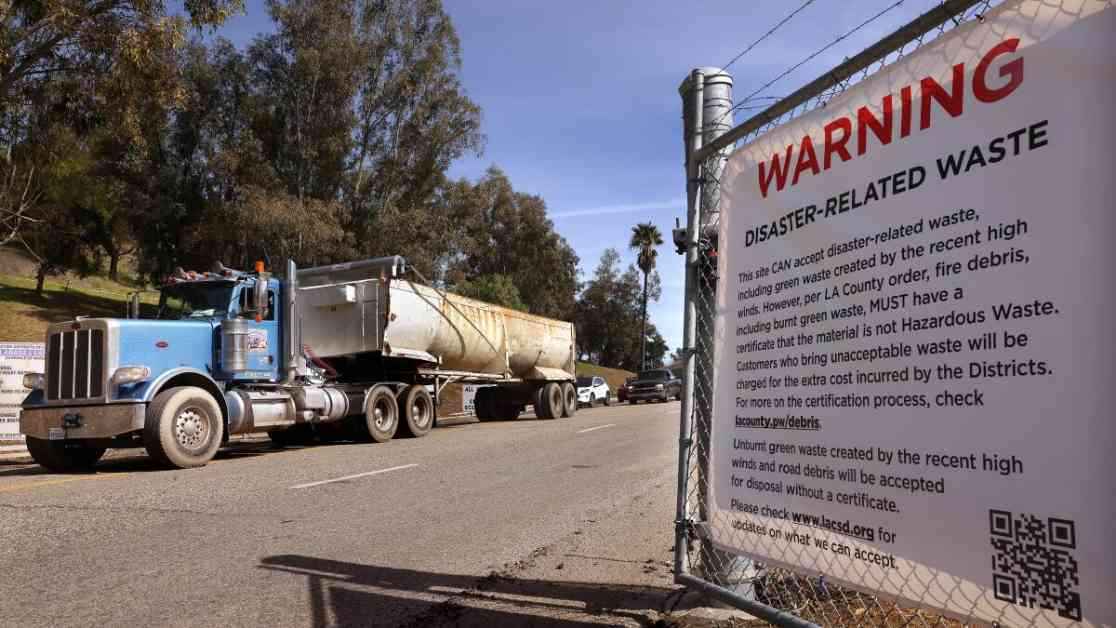Calabasas Landfill Expansion Sparks Controversy Amidst Fire Debris Disposal Concerns
In a recent decision that has sparked heated debates and protests, the Los Angeles County Board of Supervisors voted unanimously to expand the Calabasas Landfill’s capacity to accept potentially toxic wildfire debris from a wider area. This move comes in response to the recent Palisades and Eaton fires, which have left behind a trail of destruction and hazardous waste.
The Calabasas Landfill, located in the unincorporated community of Agoura, typically only accepts waste from a restricted 350-square-mile area. However, the board’s decision now allows the landfill to take in ash and debris from the entire Palisades fire burn scar, as well as potentially from other fire-affected areas. Additionally, tonnage limits have been increased at the Sunshine Canyon and Lancaster landfills to accommodate the influx of fire-related waste.
County officials have emphasized the urgent need to remove the potentially toxic-laden debris from properties destroyed in the fires, citing concerns about public health and environmental risks. Supervisor Lindsey Horvath, representing the district that includes the Calabasas and Sunshine Canyon landfills, acknowledged the community’s concerns about the safety of the material but stressed the importance of proper disposal to protect the community.
Community Concerns and Protests
However, the decision has faced significant backlash from local residents, who fear the impact of toxic ash drifting into nearby communities or contaminating the groundwater table. Residents near the landfills have expressed concerns about the long-term health effects of exposure to hazardous materials and have urged county supervisors to reconsider their decision.
Protests have erupted in various communities near the landfills, with residents voicing their opposition to the debris disposal plan. From blocking trucks entering the Calabasas Landfill to assembling at busy intersections with handmade signs, residents have made their objections clear. Kasia Sparks, a Granada Hills resident and protester, highlighted the importance of addressing health-related issues proactively to prevent long-term consequences for the community.
Public health officials have confirmed that the wildfire ash likely contains a range of toxic substances, including lead and arsenic, which can have serious health implications. While typically hazardous waste facilities handle such materials, emergency waivers have allowed for the disposal of wildfire debris in regular landfills, raising concerns about the potential risks associated with this decision.
Legal Challenges and Safety Measures
In response to the expansion of the Calabasas Landfill’s capacity, the Calabasas City Council has taken legal action to block the acceptance of wildfire debris in the landfill. Citing concerns about the proximity of homes and schools to the landfill, city officials have emphasized the need to prevent irreparable harm to the community.
Meanwhile, Calabasas residents have taken matters into their own hands by raising funds to hire private attorneys to challenge the county’s decision in court. Without proper testing and safety measures in place, residents argue that the safety of nearby communities cannot be guaranteed, adding another layer of complexity to the ongoing debate.
While county officials have assured residents that safety protocols will be followed to minimize exposure to hazardous materials, the controversy surrounding the Calabasas Landfill expansion continues to unfold. As the community grapples with the aftermath of the recent wildfires, the balance between public health and environmental concerns remains a pressing issue that requires thoughtful consideration and dialogue.


